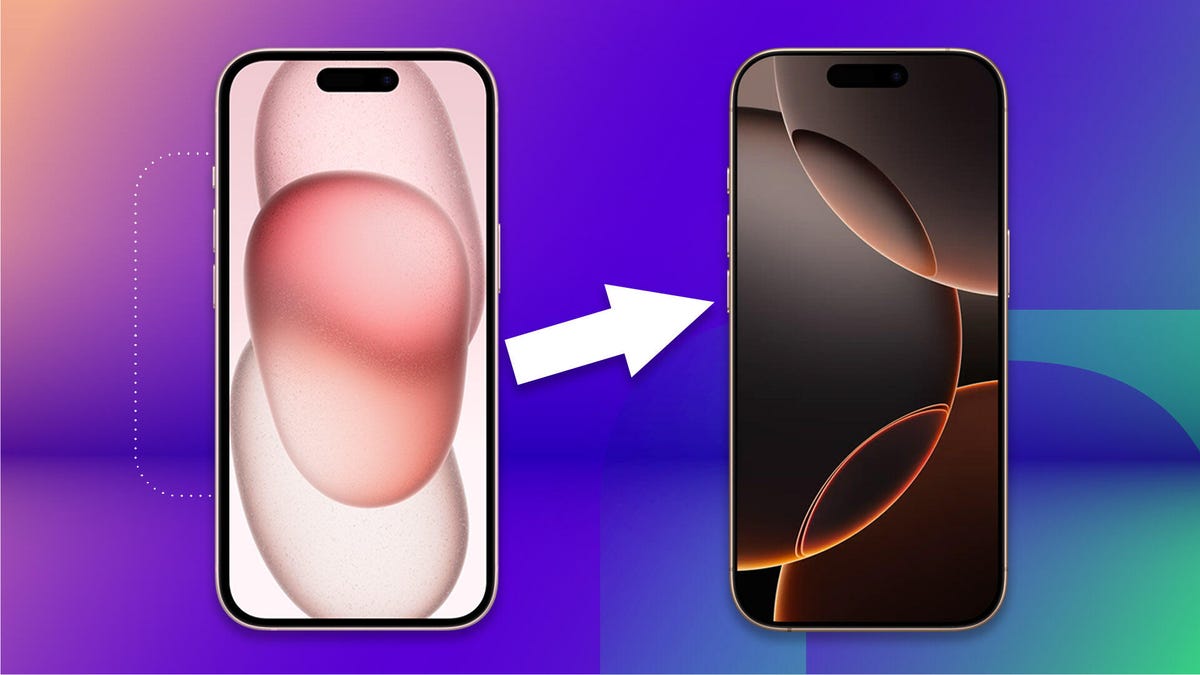Technologies
I Used to Dread Transferring My Data to a New iPhone, Until I Learned the Right Steps
These are the best no-hassle approaches to safely moving your information between phones, even including Android.

I’ve been shuffling my personal data from iPhone to iPhone since the very first model. I’d get anxious about whether I was moving everything over safely, or if I’d need to start over and lose hours of waiting. Because when you get a brand-new phone, you’d rather spend your time configuring the most important settings the way you like, or exploring new features, like Apple Intelligence.
Fortunately, it’s easier than ever to shift data to a new iPhone from the phone you have now — even if it’s an Android model.
I’m here to break down the four ways to easily transfer your data from your old phone to your new iPhone, whether you’re starting with a new iPhone 16 or a different model replacing your old device.
If you’re upgrading your current phone to the latest operating system, here’s how to download iOS 18, and here’s our review of iOS 18. And if it’s an iPhone 15 Pro or later, get up to speed on what Apple Intelligence offers.
For more, explore a bunch of hidden iOS 18 features, and learn everything you can do with the iPhone 16’s new camera button.
Read more: A Billion Pixels a Second: A Rare Look Inside Apple’s Secret iPhone 16 Camera Labs
1. Restore from iCloud
During the setup process, you’ll be asked if you want to directly transfer apps and information from your old iPhone to your new one using Quick Start. This feature was first rolled out with iOS 12.4, so if it’s been several years since you’ve upgraded phones, it’ll be the first time you’ve seen the option. The easiest and quickest method to set up your new iPhone is to restore from a recent iCloud backup. As you walk through the initial setup process, tap Restore from iCloud Backup, sign in with your Apple Account (previously called Apple ID before iOS 18) and then pick the most recent backup of your old iPhone.
If the backup is more than a day or two old, take an extra few minutes to create a new backup. To do so, open the Settings app on your old phone, search for iCloud Backup in the Search field at the top of the screen and then click the matching result. Click Back Up Now to update the cloud backup.
Once that finishes, go back to your new iPhone and select the backup you just created as what you want to use to restore from.
Your phone will then restore your settings and preferences, and you’ll be able to start using it in about 15 minutes. It will continue downloading your installed apps in the background.
Once everything is restored, you’ll need to sign back into any accounts you added to your phone, as well as go through your apps and make sure you’re still signed in.
2. Apple direct transfer
If you do not have a recent iCloud backup or your Internet connection is slow, you can transfer everything from iPhone to iPhone, either wirelessly or via cable. When the Quick Start process asks for the source, choose the direct transfer option.
Make sure you have both phones (preferably plugged in and charging to ensure they don’t run out of battery), a Wi-Fi connection and enough time for the process to finish — it could take over an hour. You can speed up that process by connecting both phones using a USB cable, but note that you might need an adapter if your current phone is an iPhone 14 or earlier with a Lightning port. Apple has more details on how to make a wired transfer work.
The more information you have on your phone, like photos in your camera roll, the longer it will take. When the transfer starts, the phones will show you a time estimate. Every time we’ve used this tool, that estimate has been accurate within a couple of minutes. It’s worth taking the time if you don’t use Apple’s iCloud service to back up your phone.
3. Use a Mac or PC
The method I use with every new iPhone is to restore from an encrypted backup using a Mac or PC. Not only does this process transfer all of your apps, settings and preferences, but it also means you don’t have to sign into the countless apps you have on your phone.
Before you can use this method, you’ll need to create an encrypted backup of your current iPhone. I know that may sound intimidating or overly complicated, but it only means you have to check an extra box and enter a password.
On a Mac, you’ll use Finder to back up your old iPhone. We outlined the steps when Apple killed iTunes. Just make sure to check the Encrypt backup box and enter a password you’ll remember when prompted. Let your Mac go to work, creating a backup file. It will let you know when it’s done.
On a PC, you’ll need to use iTunes (it’s not completely dead) to create a backup. That process is explained here. Again, you’ll need to make sure the Encrypt backup box is checked and enter a password.
To restore your new phone, open Finder or iTunes, and connect your phone to your computer. Click Trust when prompted, and then follow the prompts, selecting the backup you just created as what you want to use to restore the phone. You will need to enter the backup’s password before the process begins, so make sure you don’t forget it.
Once it’s done, your new phone will be an exact copy of your old phone and you won’t have to spend any time signing into apps or random accounts.
4. Move to iOS for Android users
Apple doesn’t have many Android apps listed in Google’s Play Store, but Move to iOS is one of them. This free app will connect your Android phone to a new iPhone and allow you to transfer the most important information from one phone to the other.
Here’s the entire step-by-step process, as well as some caveats, like the fact that it won’t transfer any locally stored music or PDF files.
Apple said it has redesigned Move to iOS to make it faster and easier to migrate from your Android phone to your new iPhone. The company goes on to say it has sped up Wi-Fi migration with transfer speeds up to 5GHz, and you can use Wi-Fi on your iPhone to connect to your Android phone. You can also connect your Android phone to your new iPhone with a USB-C or USB-C to Lightning cable to move everything over more quickly, Apple said.
No matter the process you used to set up your new phone, you’re in for excitement and fun as you explore what it can do.
Here is what you can do with the new iPhone 16 camera button and your monthly reminder to clear your iPhone cache.
Technologies
Live-Action ‘Call of Duty’ Movie Reportedly Being Co-Written by Taylor Sheridan
The Yellowstone co-creator will reportedly team up with Peter Berg on the Paramount film.

Yellowstone, Landman and, now, Call of Duty. Taylor Sheridan, co-creator of the aforementioned hit shows, will co-write Paramount and Activision’s upcoming live-action video game adaptation, according to a report from Variety on Thursday.
Peter Berg will also co-write and direct the movie, which was announced last month. Berg previously directed films including 2018’s Mile 22, 2012’s Battleship and 2013’s Lone Survivor, while Sheridan’s movie credits include 2016’s Hell or High Water and 2017’s Wind River. Berg, Sheridan and David Glasser will produce the Call of Duty film.
Don’t miss any of our unbiased tech content and lab-based reviews. Add CNET as a preferred Google source.
Call of Duty is a first-person shooter military video game series that debuted in 2003. CNET senior writer David Lumb calls it «arguably the biggest shooter franchise in gaming, with millions of players picking up every year’s new entry to the series.»
Lumb said the franchise is known for its bombastic single-player campaigns, which feature globe-spanning plots that rival those of the Mission Impossible films. «A Call of Duty movie has a lot of material to draw from,» Lumb said.
He also noted that Berg’s direction of Lone Survivor would fit the grim military heroism of Call of Duty, while Taylor Sheridan’s spate of neo-Western films and shows could lend a frontier adventurism to the film.
«Their collective works seemingly harmonize with the jingoistic pro-military tune of Activision’s shooter franchise — which is probably a good thing for Call of Duty fans,» Lumb concluded.
A release announcing Paramount and Activision’s film deal teased that it’ll be «designed to thrill its massive global fan base by delivering on the hallmarks of what fans love about the iconic series, while boldly expanding the franchise to entirely new audiences.» It didn’t include cast or plot information.
The update follows recent news that Sheridan is leaving Paramount for NBCUniversal. Paramount did not immediately respond to a request for comment.
Technologies
US Government Urges Total Ban of Our Most Popular Wi-Fi Router
Technologies
Animal Crossing Update Adds Lego Furniture, With a Switch 2 Version Arriving the Same Day
Fans of Animal Crossing will have a reason to go back to their island.

Animal Crossing fans just received a big surprise, and it’s not just a new content update. A Switch 2 version is on its way.
Animal Crossing: New Horizons will receive its first big update in three years, according to a post from Nintendo on Thursday. The update, labeled 3.0, will roll out on Jan. 15, the same day the Switch 2 version of the game will be available for purchase.
Released for the original Switch back in 2020, New Horizons was the first Animal Crossing game to come to a Nintendo console since 2008’s Animal Crossing: City Folk for the Nintendo Wii.
Nintendo regularly updated New Horizons for two years after its release, but stopped at update 2.0.6 released in November 2022. Two updates were added earlier in the year to prepare the game for playability on the Switch 2.
Animal Crossing 3.0 Update
In the 3.0 update coming on Jan. 15, a new hotel is opening. Players can help bring in guests to stay at the hotel by decorating guest rooms and dressing up mannequins to sell resort clothing.
For those who haven’t touched New Horizons in years, a Reset Service will be available. Players can have their island cleaned up, and items can be stored away or trashed for those who want a clean slate.
Players with a Nintendo Switch Online membership will have access to up to three islands, where they can explore and do as they please. These new areas are available on Slumber Island. It’s up to the player to decide how the island will look, what items or plants are on it and even which characters will be found on the island. Players can also invite friends to build it together.
New Horizons will feature special collaborations and Nintendo retro gear. Lego items will be available in the update for players to decorate their homes with or clothing to dress up their villagers with. Retro Nintendo consoles, such as the NES and Game Boy, can also be used as decorative items.
If the player has a Switch Online subscription, some classic titles such as Ice Climbers and Dr. Mario can be played via these in-game devices. There are also special items based on The Legend of Zelda and Splatoon series when players tap their amiibo from those games onto the Switch while playing.
Animal Crossing: New Horizons on Switch 2
Switch 2 owners can get in on the digital life game with Animal Crossing: New Horizons — Nintendo Switch 2 Edition. Not only will this new version come with updated graphics, including 4K resolution in TV mode, but it will also add special features that can only be done on the newest console.
One of the features is mouse controls for the Joy-Con 2. Players will be able to use the controller as a mouse to decorate indoors, create custom designs and write handwritten messages for the bulletin board.
Residents in the game can now be found by saying their name into the Switch 2’s built-in microphone while using the megaphone in the game. Multiplayer has also improved dramatically, with 12-player sessions available for those playing on the new edition, and CameraPlay is supported to allow players to see one another.
Animal Crossing: New Horizons for the Nintendo Switch 2 will be available for purchase on Jan. 15 for $65. Owners of the original Switch version of New Horizons can upgrade to the Switch 2 version for $5.
-

 Technologies3 года ago
Technologies3 года agoTech Companies Need to Be Held Accountable for Security, Experts Say
-

 Technologies3 года ago
Technologies3 года agoBest Handheld Game Console in 2023
-

 Technologies3 года ago
Technologies3 года agoTighten Up Your VR Game With the Best Head Straps for Quest 2
-

 Technologies4 года ago
Technologies4 года agoVerum, Wickr and Threema: next generation secured messengers
-

 Technologies4 года ago
Technologies4 года agoBlack Friday 2021: The best deals on TVs, headphones, kitchenware, and more
-

 Technologies4 года ago
Technologies4 года agoGoogle to require vaccinations as Silicon Valley rethinks return-to-office policies
-

 Technologies4 года ago
Technologies4 года agoOlivia Harlan Dekker for Verum Messenger
-

 Technologies4 года ago
Technologies4 года agoiPhone 13 event: How to watch Apple’s big announcement tomorrow
